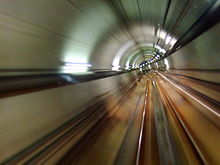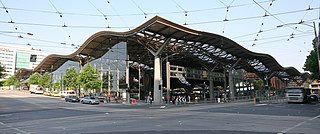
Southern Cross railway station is a major railway station in Docklands, Melbourne. It is on Spencer Street, between Collins and La Trobe Streets, at the western edge of the Melbourne Central Business District. The Docklands Stadium sports arena is 500 metres north-west of the station.
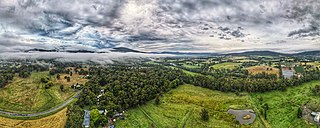
Yarra Junction is a town in Victoria, Australia, 55 km (34 mi) east from Melbourne's central business district, located within the Shire of Yarra Ranges local government area. Yarra Junction recorded a population of 2,875 at the 2021 census.

Parliament railway station is an underground railway station in Melbourne, Australia. It is one of three underground stations on the City Loop, which serves the Melbourne CBD. In 2017/2018 it was the fourth-busiest station on Melbourne's metropolitan network, with 10.19 million passenger movements.

Sunshine railway station is located on the Sunbury line in Victoria, Australia. Originally named Braybrook Junction for the convergence of the major railways from central Melbourne to Ballarat and Bendigo, it was renamed when the suburb of Sunshine, which it serves, took its name from the nearby Sunshine Harvester Works. With the expansion of the railway network in Melbourne's west, Sunshine grew in importance, with cross-suburban goods routes constructed to Newport and from the adjacent Albion to Jacana line. From the mid-20th century, it became an interchange for the main interstate routes to South Australia and New South Wales, when the through line from Melbourne to Sydney was completed, although the main line to Adelaide was later diverted. In the early 21st century, the station was demolished and reconstructed to serve the diversion of the main passenger route to Geelong and beyond. It has been identified as a possible route for a future line to Melbourne Airport and as an interchange for the orbital Suburban Rail Loop.

Footscray railway station is the junction for the Sunbury, Werribee and Williamstown lines in Victoria, Australia. It serves the western Melbourne suburb of Footscray, and it opened on 17 January 1859.

Proposals for expansion of the Melbourne rail network are commonly presented by political parties, government agencies, industry organisations and public transport advocacy groups. The extensions proposed take a variety of forms: electrification of existing routes to incorporate them into the suburban rail system; reconstruction of former passenger rail lines along pre-existing easements; entirely new routes intended to serve new areas with heavy rail or provide alternative routes in congested areas; or track amplification along existing routes to provide segregation of services. Other proposals are for the construction of new or relocated stations on existing lines, to provide improved access to public transport services.

St Kilda station is a current tram stop and former railway station, located in the Melbourne suburb of St Kilda, Australia, and was the terminus of the St Kilda railway line in the Melbourne suburban rail system. It is one of the oldest surviving railway station buildings in Victoria. The building is currently used as retail premises, while the platform serves as stop 132 on tram route 96.

The Barwon River is a perennial river of the Corangamite catchment, located in The Otways and the Bellarine Peninsula regions of the Australian state of Victoria.
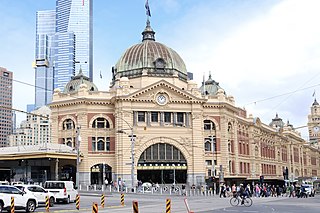
The Melbourne rail network is a passenger and freight train system in the city of Melbourne, Victoria, Australia. The metropolitan passenger rail network is centred on the Melbourne CBD and consists of 222 stations across 16 lines, which served a ridership of 99.5 million over the year 2021-2022. It is the core of the larger Victorian railway network, with links to both intrastate and interstate systems.
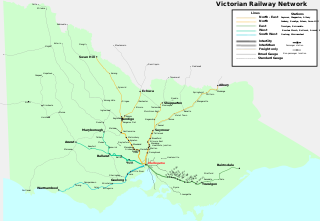
Rail transport in the Australian state of Victoria is provided by a number of railway operators who operate over the government-owned railway lines. The network consists of 2,357 km of Victorian broad gauge lines, and 1,912 km of standard gauge freight and interstate lines; the latter increasing with gauge conversion of the former. Historically, a few experimental 762 mm gauge lines were built, along with various private logging, mining and industrial railways. The rail network radiates from the state capital, Melbourne, with main interstate links to Sydney and to Adelaide, as well as major lines running to regional centres, upgraded as part of the Regional Fast Rail project.
Australians generally assumed in the 1850s that railways would be built by the private sector. Private companies built railways in the then colonies of Victoria, opened in 1854, and New South Wales, where the company was taken over by the government before completion in 1855, due to bankruptcy. South Australia's railways were government owned from the beginning, including a horse-drawn line opened in 1854 and a steam-powered line opened in 1856. In Victoria, the private railways were soon found not to be financially viable, and existing rail networks and their expansion were taken over by the colony. Government ownership also enabled railways to be built to promote development, even if not apparently viable in strictly financial terms. The railway systems spread from the colonial capitals, except in cases where geography dictated a choice of an alternate port.
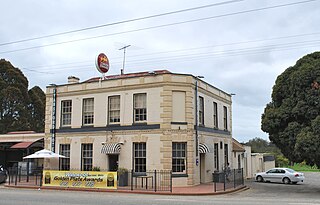
Fyansford is a township on the western edge of Geelong, Victoria, Australia, named after Captain Foster Fyans who came to Geelong as a Police magistrate in October, 1837. It is located at the junction of the Barwon and Moorabool rivers. At the 2016 census, Fyansford had a population of 196.

The Moorabool River is a river in Victoria, Australia, that runs past several small towns and areas such as Meredith, Anakie, and Staughton Vale. The river joins with the Barwon River at Fyansford.
The Deniliquin railway line is a broad-gauge railway line serving northwestern Victoria, Australia. The line runs from the border settlement of Deniliquin into Bendigo, before turning south-southeast towards Melbourne, terminating in Docklands near the central business district. It is a major trunk line both for passenger and freight trains, with many railway lines branching off from it.

Rail transport in Australia involves a number of narrow-gauge railways. In some states they formed the core statewide network, but in the others they were either a few government branch lines, or privately owned and operated branch lines, often for mining, logging or industrial use.

Powelltown is a town in Victoria, Australia, 70 km east of Melbourne's central business district, located within the Shire of Yarra Ranges local government area. Powelltown recorded a population of 214 at the 2021 census.

The Powelltown tramway was a 3 ft narrow gauge tramway that operated between Powelltown and Yarra Junction, Victoria, Australia, between 1913 and 1945.

The earliest trams in Australia operated in the latter decades of the 19th century, hauled by horses or "steam tram motors". At the turn of the 20th century, propulsion almost universally turned to electrification, although cable trams lingered in Melbourne. In cities and towns that had trams, they were a major part of public transport assets.
The Geelong–Ballarat railway line is a broad-gauge railway in western Victoria, Australia between the cities of Geelong and Ballarat. Towns on the route include Bannockburn, Lethbridge, Meredith, Elaine and Lal Lal. Major traffic includes general freight from the Mildura line, and grain.
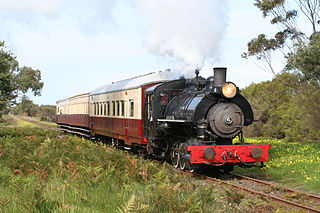
The Fyansford Cement Works Railway was an industrial railway near Geelong, Australia, built by the Australian Portland Cement Company to carry limestone from its quarry to its cement works at Fyansford.


